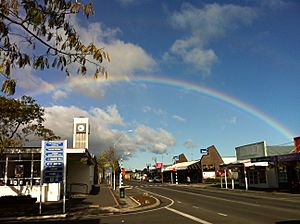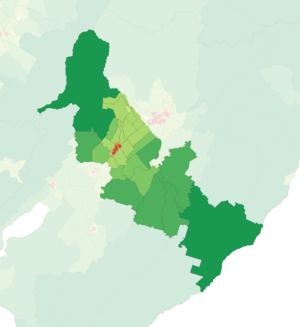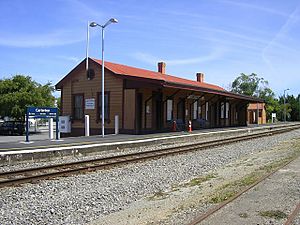Carterton, New Zealand facts for kids
Quick facts for kids
Carterton
Taratahi (Māori)
|
|
|---|---|
|
Minor urban area
|
|

Central Carterton
|
|
| Motto(s):
Daffodil capital
|
|

Carterton district within the North Island
|
|
| Country | New Zealand |
| Region | Wellington Region |
| Territorial authority | Carterton District |
| Town founded | 1857 |
| Named for | Charles Carter |
| Electorates |
|
| Area | |
| • Territorial | 1,179.91 km2 (455.57 sq mi) |
| • Urban | 5.30 km2 (2.05 sq mi) |
| Elevation | 77 m (253 ft) |
| Population
(June 2023)
|
|
| • Territorial | 10,250 |
| • Density | 8.687/km2 (22.499/sq mi) |
| • Urban | 5,960 |
| • Urban density | 1,124.5/km2 (2,913/sq mi) |
| Time zone | UTC+12 (NZST) |
| • Summer (DST) | UTC+13 (NZDT) |
| Postcode(s) |
5713
|
| Area code(s) | 06 |
| Website | www.cdc.govt.nz District Council |
Carterton (Māori: Taratahi) is a small town in the Wellington Region of New Zealand. It is also the main town of the Carterton District, which is a local government area. The town is in a farming area called the Wairarapa in New Zealand's North Island.
Carterton is about 14 kilometers (9 miles) southwest of Masterton. It is also about 80 kilometers (50 miles) northeast of Wellington, the capital city. The town itself has a population of about 5,960 (June 2023 people. The whole district has a population of around 10,250 people.
The town of Carterton was started in 1857. It was first called Three Mile Bush. This was because it provided homes for workers building a road. This road connected Wellington and Masterton. The town was later named after Charles Carter. He was in charge of building the Black Bridge over the Waiohine River. Carterton calls itself New Zealand's daffodil capital. Every year, it holds a fun Daffodil Festival. This festival happens on the second Sunday in September. The main event takes place at Middle Run along Gladstone Road.
Contents
History
Carterton has a special place in history. It was the first place in the world to elect a pioneering leader, Georgina Beyer, as mayor. She later made history again. In 1999, she became a Member of Parliament for the Wairarapa area.
On January 7, 2012, a hot air balloon had a tragic accident near the town. Eleven people lost their lives. The balloon touched a power line. This caused the balloon to catch fire. The town briefly lost electricity. In 1956, Carterton and Masterton were the first towns in New Zealand to use the 111 Emergency Number. This number is for urgent help.
People and Population
Carterton Town
Carterton town covers about 5.30 square kilometers (2.05 sq mi). Its estimated population is 5,960. This means there are about 1125 people per square kilometer.
The population of Carterton was 5,859 in the 2023 New Zealand census. This was an increase of 516 people since 2018. It was also an increase of 1,119 people since 2013. The average age of people in Carterton was 50.5 years. About 16.2% of the people were under 15 years old.
Most people in Carterton are European (89.6%). About 16.0% are Māori. Other groups include Pasifika (2.9%) and Asian (3.8%). English is spoken by 97.7% of people. The Māori language is spoken by 2.7%.
Many people in Carterton have no religion (57.9%). About 30.6% identify as Christian.
Carterton District
The Carterton District covers a larger area, about 1179.91 square kilometers (455.57 sq mi). Its estimated population is 10,250. This means there are about 8.7 people per square kilometer.
The population of Carterton District was 10,107 in the 2023 New Zealand census. This was an increase of 909 people since 2018. It was also an increase of 1,872 people since 2013. The average age in the district was 48.4 years. About 17.7% of people were under 15 years old.
Most people in the district are European (91.2%). About 14.1% are Māori. English is spoken by 97.9% of people. The Māori language is spoken by 2.4%.
Cool Places to Visit
Carterton has several interesting landmarks.
Town Clock
The town clock is on High Street, next to the post office. The current clock tower was built in 1962. It replaced an older clock tower. The old one was damaged in an earthquake in 1942.
Historic Bank Building
The Bank of New South Wales built a beautiful bank building in 1912. It is on the corner of Park Road and High Street North. This building is very old and important. In 1982, the bank became Westpac. An earthquake in 2011 damaged many old buildings. After that, the bank moved out. The building was made stronger. In 2017, it reopened as the Carterton Free Presbyterian Church.
Carterton Railway Station
The historic Carterton railway station is west of the town center. The station building is original. It was built in 1880 when the railway first opened. Trains have been stopping there ever since. A group called the Wairarapa Railway Restoration Society now looks after it.
Carterton Library
The Carterton District library started in 1874. It is one of New Zealand's oldest public libraries. The library building was built in 1881. It is on Holloway Street. This is the oldest building in the country made just for a library.
Carterton Events Centre
The Carterton Events Centre is also on Holloway Street. It opened in October 2011. This is a modern building for many uses. It can host events, shows, meetings, and community gatherings. It has flexible spaces that can be changed for different needs. The Events Centre belongs to the Carterton community.
Memorial Square
Carterton's Memorial Square is at the corner of High Street and Park Road. It has a memorial for World War One. The memorial is a red granite pillar. It looks like it is broken at the top. This symbolizes the lives that were cut short by the war. The memorial was revealed in 1921.
Since 2015, the Square has hosted the Carterton Farmers' Market. This market sells local produce and crafts. It happens every Sunday.
Stonehenge Aotearoa
About 10 minutes from the Square is Stonehenge Aotearoa. This is a modern version of the famous Stonehenge in England. It was built by The Phoenix Astronomy Society. It opened in 2005.
Schools
Carterton has several schools for young people.
Primary Schools
- Carterton School is a state primary school. It teaches students from Year 1 to Year 8. It has about 227 students. The school opened in 1861.
- South End School is another state primary school. It also teaches students from Year 1 to Year 8. It has about 181 students. This school opened in 1962.
- St Mary's School is a Catholic primary school. It teaches students from Year 1 to Year 8. It has about 126 students. The school opened in 1917.
Other Schools
- Ponatahi Christian School is a Christian school. It teaches students from Year 1 to Year 13. It has about 124 students. It started as a private school in 1978. It moved to its current location in 1996–97.
Carterton does not have any state secondary schools. The closest secondary schools are Kuranui College in Greytown. This is about 10 km away. Also, Wairarapa College and Makoura College are in Masterton. They are about 14 km and 15 km away.
Getting Around
Roads
The main street in Carterton is High Street. It is split into High Street North and High Street South. Other important streets include Park Road and Belvedere Road.
Carterton District is growing fast. Many new housing areas have been built. These include Hartley Avenue and Daffodil Grove.
State Highway 2 runs through Carterton. This is the main highway between Wellington and Masterton. It runs along High Street.
Carterton also has a bus service called Metlink bus route 200. This bus connects Carterton to Masterton, Greytown, Featherston, and Martinborough.
Rail
Carterton is on the Wairarapa Line. This is a railway line. The Wairarapa Connection train serves Carterton. This train connects Carterton to Wellington. The train stops at both Carterton railway station and Matarawa railway station.
Famous People from Carterton
- Georgina Beyer, a pioneering mayor and Member of Parliament.
- Sir Bob Charles, a famous golfer. He was the first left-handed golfer to win a major golf championship.
- Herbert Ernest Hart, a World War I commander. He was born in Taratahi.
- Madeleine Marie Slavick, a writer and photographer.
- Ron Mark, a politician and current mayor of Carterton.
- Celia Manson, a writer and journalist.
- Marion Tylee, an artist.
- Hamuera Tamahau Mahupuku, a Māori tribal leader and newspaper owner.
Images for kids
See also
 In Spanish: Carterton (Nueva Zelanda) para niños
In Spanish: Carterton (Nueva Zelanda) para niños







